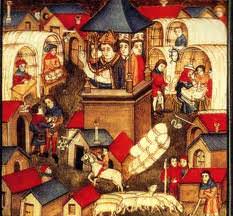Medieval Market Design: Product Grouping on Medieval Fairs
Boerner, Lars (Humboldt University Berlin)
Paper given at the European Historical Economics Society Conference (2005)
Abstract
This paper presents insights into the market microstructure of the late Middle Ages, particularly the market design of medieval fairs. It shows that different product genres were grouped. This grouping was seller optimal as well as socially efficient. Based on a model of product differentiation with ex ante uncertainty about the optimal trading partner, strategic interacting merchants will locate next to each other. This also minimizes search costs of the potential customers and is therefore socially efficient. This paper finds evidence that such an equilibrium was driven by both the town officials and the sellers. Furthermore, it documents that it evolved over time.
If we go for a walk in the old towns of Europe, we often find streets named “Book Lane,” and “Linen Street.,” These names indicate which goods were sold on these streets. They belonged to the medieval market terrain. Every medieval town had a market. Markets were strictly designed and organized by the town officials and were the cornerstone of any public exchange. It does not matter if these were weekly fish or grain markets or yearly fairs.
Medieval Market Design: Product Grouping on Medieval Fairs
Boerner, Lars (Humboldt University Berlin)
Paper given at the European Historical Economics Society Conference (2005)
Abstract
This paper presents insights into the market microstructure of the late Middle Ages, particularly the market design of medieval fairs. It shows that different product genres were grouped. This grouping was seller optimal as well as socially efficient. Based on a model of product differentiation with ex ante uncertainty about the optimal trading partner, strategic interacting merchants will locate next to each other. This also minimizes search costs of the potential customers and is therefore socially efficient. This paper finds evidence that such an equilibrium was driven by both the town officials and the sellers. Furthermore, it documents that it evolved over time.
costs of the potential customers and is therefore socially efficient. This paper finds evidence that such an equilibrium was driven by both the town officials and the sellers. Furthermore, it documents that it evolved over time.
If we go for a walk in the old towns of Europe, we often find streets named “Book Lane,” and “Linen Street.,” These names indicate which goods were sold on these streets. They belonged to the medieval market terrain. Every medieval town had a market. Markets were strictly designed and organized by the town officials and were the cornerstone of any public exchange. It does not matter if these were weekly fish or grain markets or yearly fairs.
Click here to read this paper from the European Historical Economics Society Conference
Subscribe to Medievalverse
Related Posts